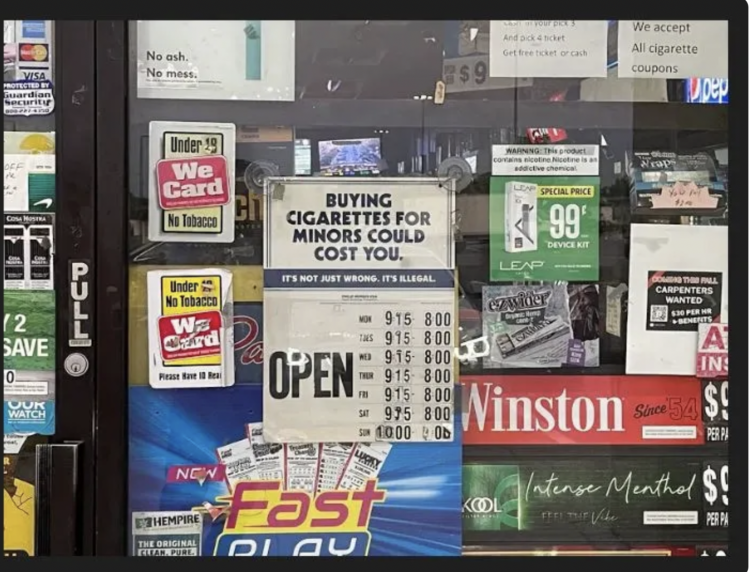
In eastern Baltimore County, Maryland, middle and high school students gather around a small corner store located near Kenwood High School and Stemmers Run Middle School, after school. The store's banner advertises items such as milk, candy, coffee, cigarettes, and tobacco. Window advertisements showcase Marlboro cigarette advertisements on the left side, and Juul e-cigarette advertisements on the right side.
A one-stop convenience store located between a high school and middle school in Essex County is a popular spot for teenagers to hang out and often vape. High schoolers report that it is easy to buy tobacco products at nearby retail stores. This store is one of many in Baltimore County concentrated in low-income communities. According to research by researchers at John Hopkins University, the concentration of tobacco retailers in low-income communities is almost twice that of high-income communities in Baltimore.
This is part of a legacy that tobacco companies have targeted low-income communities, predominantly Black and Brown communities, as well as young people for decades, and this legacy continues to this day.
Kenneshia Williams, research manager at the Truth Initiative, a non-profit organization dedicated to providing young people with facts about the dangers of tobacco and the tobacco industry, stated, "This is a diverse group of people intended to be the biggest users of these products, and it's certainly harmful to people.
According to a study by researchers from Stanford University, the University of North Carolina at Chapel Hill, and Saint Washington University, over 87% of tobacco retailers in Baltimore are within 1000 feet of public schools. This targeting of vulnerable populations by tobacco companies, including Black and brown communities, LGBTQ+ individuals, veterans, and those with mental health issues, has been a longstanding issue. These companies offer menthol-flavored cigarettes, coupons for purchasing tobacco products, and sell single cigarettes to make it easier to access. Lewis Williams, from the Youthcast Media Group, spoke to this issue.
This objective also targets young people. According to the 2021 Youth Tobacco Survey, nearly 75% of American middle and high school students reported being exposed to at least one source of electronic cigarette and tobacco advertisements while engaging in daily activities such as going to the movies or visiting local stores.
According to county health officials, in 2016, it was reported that nearly 17% of adolescents in Baltimore County had used tobacco products. In 2019, tobacco use among middle school students in Maryland was highest among African American youth.
Distance and accessibility still remain as issues.
Despite efforts to reduce tobacco use among young people and lower smoking rates, the overall use of tobacco products, including electronic cigarettes, remains alarmingly high. While peers have the greatest influence on young people's smoking and e-cigarette use, access to tobacco products and proximity to retailers are also crucial factors.
According to a 2020 study by researchers from the Stanford University School of Medicine, the University of North Carolina at Chapel Hill, and St. Washington University, tobacco retailers are concentrated in low-income areas. In Baltimore, there are five times as many tobacco retailers per square mile in the lowest-income communities as there are in the highest-income communities.
Tobacco retailers are ubiquitous, with 63 times more retailers than McDonald's and 66 times more than Starbucks in Baltimore alone. According to a report, because there are so many, they are also easily accessible, with 80% of urban residents living within a half-mile or approximately 10-minute walk from a tobacco retailer.
Tobacco waste, including many products marketed to young people and popular among students near schools, litters the streets of the Essex community in Maryland. According to Will Cummings of Youthcast Media Group in Baltimore, over 87% of public schools in the area are located less than 1,000 feet from tobacco retailers. One such retailer, a convenience store called One Stop Shop, is situated on the edge of the district near Kenwood High School, where students frequently gather after school.
Caius Bourgeois, a 17-year-old from Baltimore County, began smoking blunt wraps at the age of 14. These inexpensive products, similar to cigars and sold individually, are often flavored with fruity tastes. Bourgeois started smoking them because his friends enjoyed them.
My friend just passed it to me, like two years ago. I thought, okay, I'll take it. He got it from the gas station next to my house. It's easy to get," he said.
Despite successfully reducing the use of tobacco among youth in Maryland, many retailers in the state are illegally selling tobacco products to minors. In 2014, the Centers for Disease Control and Prevention reported that only 37% of Maryland youth were asked to provide photo identification when purchasing cigarettes, and nearly 70% of youth smokers reported being able to illegally purchase cigarettes themselves or have older friends buy them.
Misconceptions about the use of harm-driven electronic cigarettes.
Although most young people today acknowledge that smoking can be harmful, many underestimate the dangers and potential long-term effects of smoking. According to the 2021 Youth Tobacco Survey, roughly 15-20% of middle and high school students believe that using e-cigarettes is almost harmless or has no harm at all.
Many young people not only underestimate the risks of these products, but also mistakenly believe that e-cigarettes can reduce anxiety or stress. According to the same tobacco survey, the most commonly cited reason for continued use of e-cigarettes among young people is because they feel anxious or stressed.
According to Truth Initiative's Williams, tobacco companies' advertisements often deliberately deceive young people, encouraging them to believe that smoking can relieve stress.
She said, "I know that pressure is the main reason that people turn to these products.
Gianna Darville, the liaison for the youth committee of the Truth initiative, stated that many young people are turning to electronic cigarettes as a means of improving their mental health. However, the reality is that e-cigarettes can actually make them feel worse.
Zhyier Linton, a 17-year-old student from Baltimore County, says she started smoking to help deal with family issues. "It relieved the pressure I was feeling... it helped me cope with the troubles in my life," she said.
Zhyier stated that she believes smoking, particularly electronic cigarettes, has gotten out of control among young people. She said, "There should be more rules regarding who these products are sold to.
Bree Tomlinson and Amyah Davis are senior high school students from Kenwood High School in Essex County, Maryland. They reported and wrote this story during the 2022 spring reporting workshop of Youthcast Media GroupTM and received assistance from YMG's content and program director Brie Zeltner, a former reporter for Cleveland's The Plain Dealer.
Statement:
This article is compiled from third-party information and is only intended for industry exchanges and learning.
This article does not represent the views of 2FIRSTS, and 2FIRSTS cannot confirm the truthfulness and accuracy of its content. The compilation of this article is only intended for industry exchange and research purposes.
Due to limitations in translation abilities, the translated article may not fully convey the meaning of the original text. Please refer to the original text for accuracy.
2FIRSTS maintains complete alignment with the Chinese government on any statements or positions related to domestic affairs, Hong Kong, Macau, Taiwan, and foreign affairs.
Copyright for compiled information belongs to the original media and authors. If there is any infringement, please contact us for deletion.
This document has been generated through artificial intelligence translation and is provided solely for the purposes of industry discourse and learning. Please note that the intellectual property rights of the content belong to the original media source or author. Owing to certain limitations in the translation process, there may be discrepancies between the translated text and the original content. We recommend referring to the original source for complete accuracy. In case of any inaccuracies, we invite you to reach out to us with corrections. If you believe any content has infringed upon your rights, please contact us immediately for its removal.






